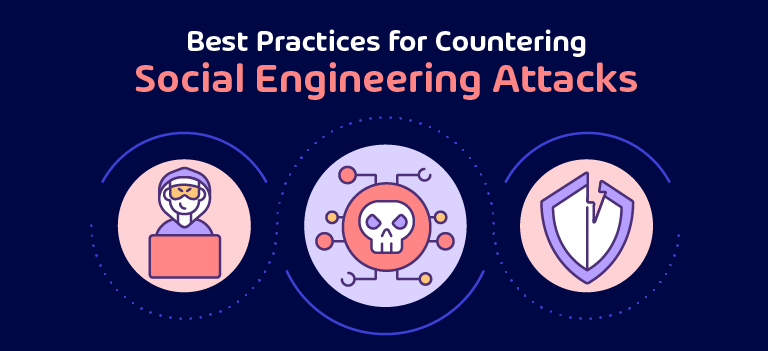Ninety-eight percent of all cyber-attacks are variations of social engineering. This implies that businesses must constantly invest in cutting-edge approaches for their cybersecurity as cybercriminals invent new ways of exploiting organizations’ vulnerabilities.
Unlike other forms of cyber-attacks, social engineering focuses on humans — this brings serious problems because humans are the weakest link in the security chain. These days, businesses worry about their cybersecurity professionals’ mental health due to the significant toll of constant attacks.
Social engineering means a broad range of psychological manipulation of people to perform acts that prompt them to divulge sensitive information. Social engineering can be phishing, pretexting, and so on. Social engineering attacks can, however, be managed proactively when the right actions and investments are considered in an organization.
Here are some of the best practices for countering social engineering attacks:
Be consistent with your security awareness training:
Social engineering tactics are designed to work on humans. This means that organizations must continually keep their stakeholders and employees abreast of the latest cybersecurity practices with awareness programs because cyber attackers change their tactics to catch their victims off-guard. While change is constant, your defensive measures must always remain solid and impenetrable.
Manage your security with 24/7 monitoring:
Cybersecurity is about identifying threats and taking proactive measures to keep them in check. Businesses and organizations must ensure their security officers are competent enough to continually access the system’s security, identifying deceivingly innocent programs or inimical phishing campaigns so that if any team member makes a mistake, they can be quickly alerted and rectified.
Making strong security policies and protocols:
This approach is one of the top ways of protecting your organization from cyber-attacks. Organizing sensitive information appropriately and formulating policies to address security inadequacies can deter attackers in real-time. This approach can protect your data from theft and colossal damages.
SSL certification:
One of the best ways to proactively secure your data is through SSL certification. It is what encrypts your communication channels and your data. An SSL is like a padlock to a room that prevents unpermitted intrusion. Another utility of an SSL certification is that a website is more likely to be authentic — many phishing links use URLs without SSLS.
Regulating Social Media Usage and limiting your digital footprints:
An organization’s social media usage must be minimized if it attracts unwanted attention. Putting out too many details about your business can be used by cybercriminals. The attacker can use even a simple employee’s resumé detail to communicate with their target and act like they are a reputable source while using spear phishing manipulative techniques. Your workers and stakeholders should also be informed about sharing sensitive information on social media. One of our top cybersecurity predictions for 2023 is more remote work, which calls for more concerns.
Enabling and utilizing MFA:
While using passwords that are hard to predict may sometimes work, they may not be as efficient in preventing attackers from privileged access. Multi-Factor Authentication (MFA) makes it harder for any attacker — from biometrics, the mother’s paternal name, to passwords and OTPs. This level of authentication makes it harder for hackers to act swiftly without facing barriers that may alert the system in their favor.
Use the latest security packages and updates:
Most software assessments, updates, and fixes that businesses undertake are to prevent unnecessary mistakes from breaching their data. It is always necessary to use the latest applications and security patches. They can prevent hackers from accessing phishing protocol’s access without your consent. Many modern applications have introduced patches that deny your access to insecure links and websites.
Penetration testing, social simulation, and red teaming:
When tests like those mentioned above are done, a social engineering simulation can be used to access which employee would most likely fall to the ruse of attackers. Lessons can be learned, better policies can be made, and workers can be more aware of what they need to do to protect themselves and their organization. Through this measure, your data can be less prone to human errors.
Spam filtering:
Social engineering attackers love using emails to access people because it is one of the easiest ways to compromise networks and steal sensitive data. To limit their tactical click baits, mobile phone phishing, and persuasive messages, spam filters with good email gateway can restrict their access by a high degree. You can easily label attackers’ phishing or social engineering patterns with gateways.
Create strong and unpredictable passwords:
It is normal for humans to use the same password for every site. For best practices, this must be minimized to reduce an attacker’s advantage over you. Firms and enterprises should properly store their passwords in secure keychains and use the recommended unpredictable format for new passwords, including alphabetic, special, and numeric characters.
Conclusion:
Social engineering makes us aware that the best cybersecurity practices do not involve only computers but humans. The social engineering mechanisms by attackers are one of the most effective ways they breach data and compromise a sensitive network. The best ways to secure your organization and manage insider threats are not limited to the above points. However, being proactive can save you from unnecessary loss.
Emmanuel Akin-Ademola
Tags: MFA, social engineering, Social Media


